Construction Technology Report: Analysis of Hotel Construction Project
VerifiedAdded on 2023/01/18
|16
|5234
|68
Report
AI Summary
This report provides a comprehensive analysis of construction technology, focusing on the development of a new hotel near an international airport. The report begins by differentiating between residential, commercial, and industrial building types, highlighting variations in equipment, materials, and usage. It emphasizes the promotion of sustainability in construction projects, including energy-efficient site management and waste reduction strategies. The report then delves into the terminology used in construction technology, such as aggregate, beams, BIM, and BOQ. It examines pre-design studies, including site location analysis and user requirement assessments, and explores various foundation types, such as shallow and raft foundations, along with their suitability for different structures. The study also discusses site information impacting foundation plans, considering building loads and soil types. Furthermore, the report analyzes the functional characteristics of site elements, including walls, and their design selection criteria. It covers techniques for site remediation, substructure works, supply and distribution arrangements for primary services, and the impact of service distribution on overall building design. The report concludes by summarizing the key findings and emphasizing the significance of construction technology in modern building projects.
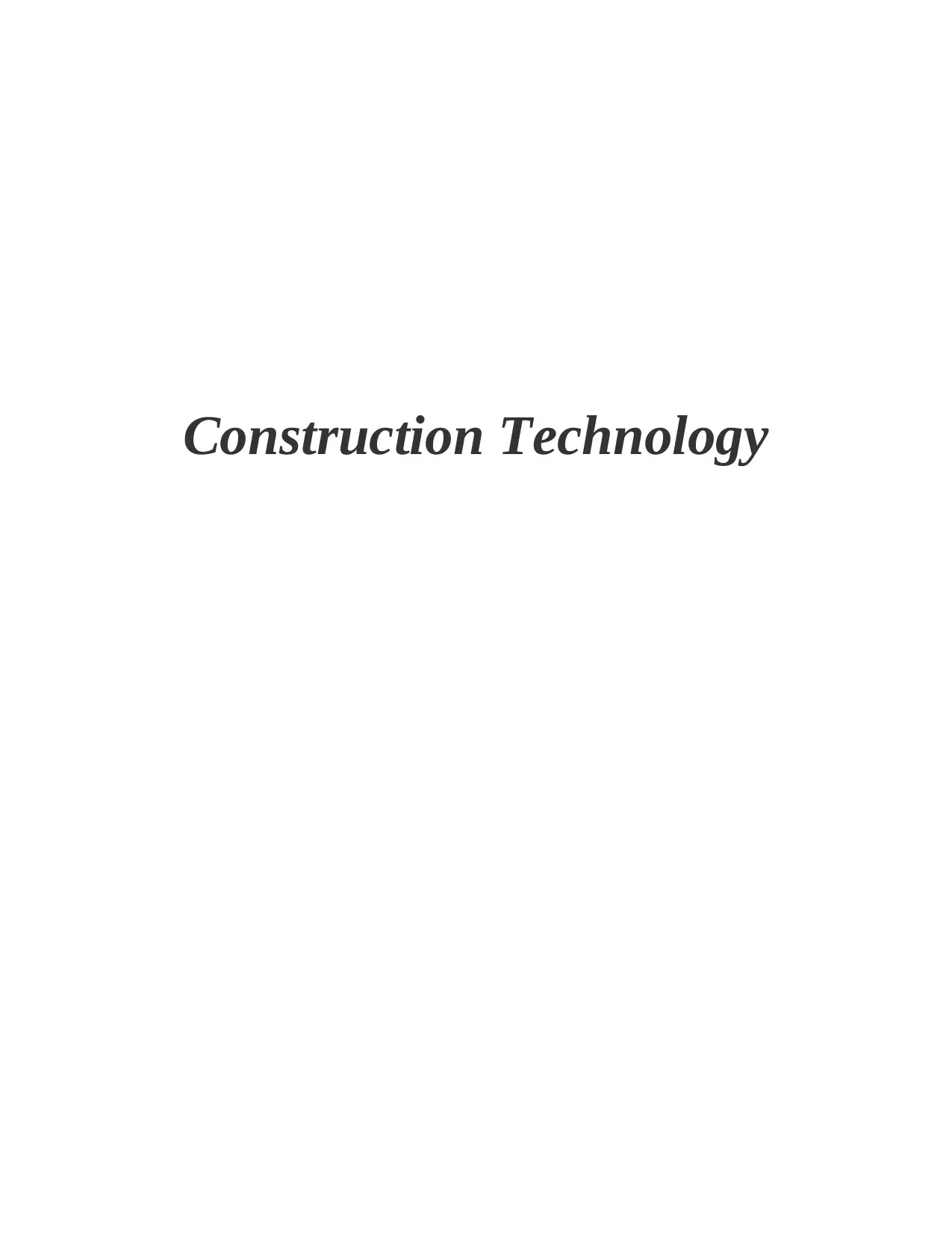
Construction Technology
Paraphrase This Document
Need a fresh take? Get an instant paraphrase of this document with our AI Paraphraser
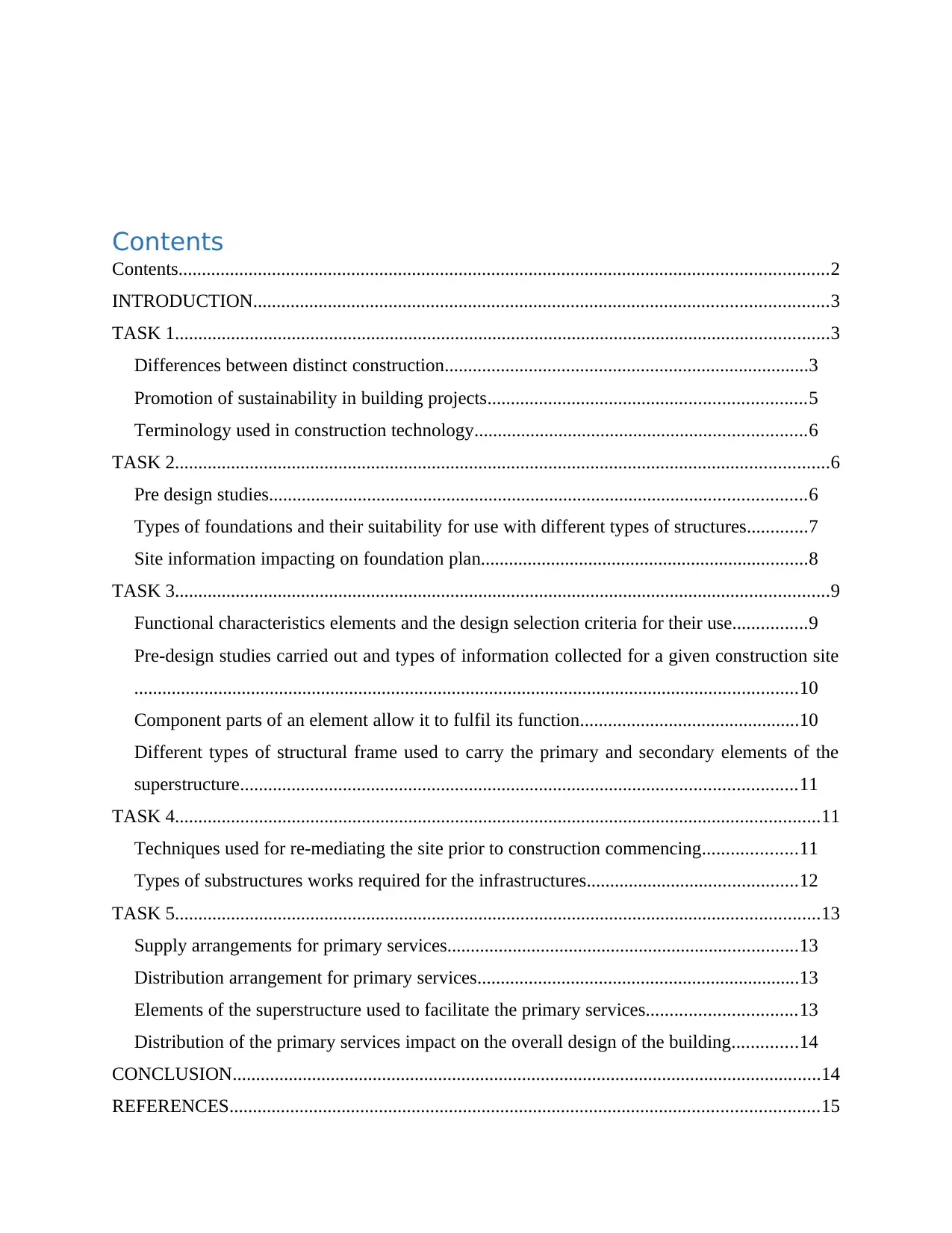
Contents
Contents...........................................................................................................................................2
INTRODUCTION...........................................................................................................................3
TASK 1............................................................................................................................................3
Differences between distinct construction..............................................................................3
Promotion of sustainability in building projects....................................................................5
Terminology used in construction technology.......................................................................6
TASK 2............................................................................................................................................6
Pre design studies...................................................................................................................6
Types of foundations and their suitability for use with different types of structures.............7
Site information impacting on foundation plan......................................................................8
TASK 3............................................................................................................................................9
Functional characteristics elements and the design selection criteria for their use................9
Pre-design studies carried out and types of information collected for a given construction site
..............................................................................................................................................10
Component parts of an element allow it to fulfil its function...............................................10
Different types of structural frame used to carry the primary and secondary elements of the
superstructure.......................................................................................................................11
TASK 4..........................................................................................................................................11
Techniques used for re-mediating the site prior to construction commencing....................11
Types of substructures works required for the infrastructures.............................................12
TASK 5..........................................................................................................................................13
Supply arrangements for primary services...........................................................................13
Distribution arrangement for primary services.....................................................................13
Elements of the superstructure used to facilitate the primary services................................13
Distribution of the primary services impact on the overall design of the building..............14
CONCLUSION..............................................................................................................................14
REFERENCES..............................................................................................................................15
Contents...........................................................................................................................................2
INTRODUCTION...........................................................................................................................3
TASK 1............................................................................................................................................3
Differences between distinct construction..............................................................................3
Promotion of sustainability in building projects....................................................................5
Terminology used in construction technology.......................................................................6
TASK 2............................................................................................................................................6
Pre design studies...................................................................................................................6
Types of foundations and their suitability for use with different types of structures.............7
Site information impacting on foundation plan......................................................................8
TASK 3............................................................................................................................................9
Functional characteristics elements and the design selection criteria for their use................9
Pre-design studies carried out and types of information collected for a given construction site
..............................................................................................................................................10
Component parts of an element allow it to fulfil its function...............................................10
Different types of structural frame used to carry the primary and secondary elements of the
superstructure.......................................................................................................................11
TASK 4..........................................................................................................................................11
Techniques used for re-mediating the site prior to construction commencing....................11
Types of substructures works required for the infrastructures.............................................12
TASK 5..........................................................................................................................................13
Supply arrangements for primary services...........................................................................13
Distribution arrangement for primary services.....................................................................13
Elements of the superstructure used to facilitate the primary services................................13
Distribution of the primary services impact on the overall design of the building..............14
CONCLUSION..............................................................................................................................14
REFERENCES..............................................................................................................................15
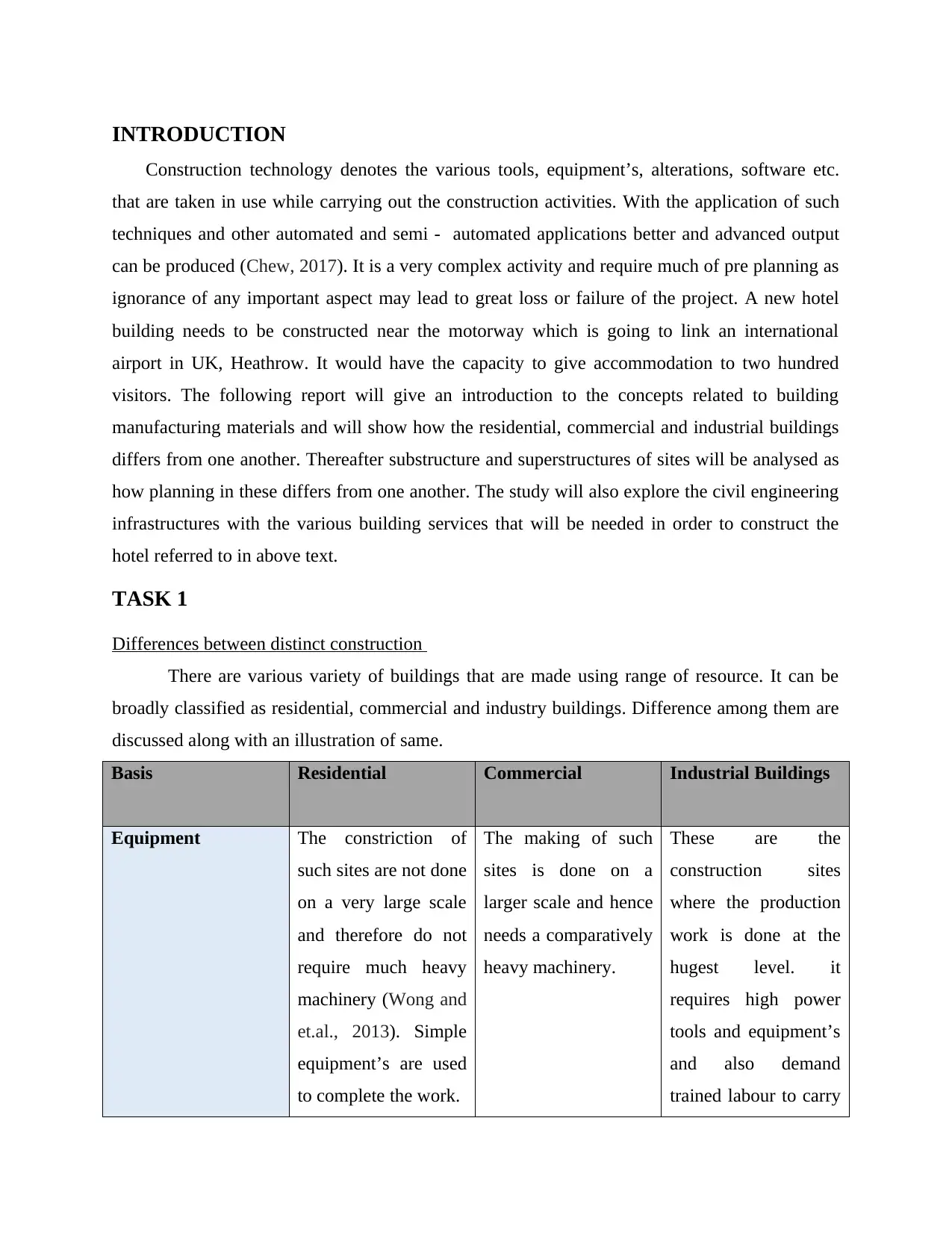
INTRODUCTION
Construction technology denotes the various tools, equipment’s, alterations, software etc.
that are taken in use while carrying out the construction activities. With the application of such
techniques and other automated and semi - automated applications better and advanced output
can be produced (Chew, 2017). It is a very complex activity and require much of pre planning as
ignorance of any important aspect may lead to great loss or failure of the project. A new hotel
building needs to be constructed near the motorway which is going to link an international
airport in UK, Heathrow. It would have the capacity to give accommodation to two hundred
visitors. The following report will give an introduction to the concepts related to building
manufacturing materials and will show how the residential, commercial and industrial buildings
differs from one another. Thereafter substructure and superstructures of sites will be analysed as
how planning in these differs from one another. The study will also explore the civil engineering
infrastructures with the various building services that will be needed in order to construct the
hotel referred to in above text.
TASK 1
Differences between distinct construction
There are various variety of buildings that are made using range of resource. It can be
broadly classified as residential, commercial and industry buildings. Difference among them are
discussed along with an illustration of same.
Basis Residential Commercial Industrial Buildings
Equipment The constriction of
such sites are not done
on a very large scale
and therefore do not
require much heavy
machinery (Wong and
et.al., 2013). Simple
equipment’s are used
to complete the work.
The making of such
sites is done on a
larger scale and hence
needs a comparatively
heavy machinery.
These are the
construction sites
where the production
work is done at the
hugest level. it
requires high power
tools and equipment’s
and also demand
trained labour to carry
Construction technology denotes the various tools, equipment’s, alterations, software etc.
that are taken in use while carrying out the construction activities. With the application of such
techniques and other automated and semi - automated applications better and advanced output
can be produced (Chew, 2017). It is a very complex activity and require much of pre planning as
ignorance of any important aspect may lead to great loss or failure of the project. A new hotel
building needs to be constructed near the motorway which is going to link an international
airport in UK, Heathrow. It would have the capacity to give accommodation to two hundred
visitors. The following report will give an introduction to the concepts related to building
manufacturing materials and will show how the residential, commercial and industrial buildings
differs from one another. Thereafter substructure and superstructures of sites will be analysed as
how planning in these differs from one another. The study will also explore the civil engineering
infrastructures with the various building services that will be needed in order to construct the
hotel referred to in above text.
TASK 1
Differences between distinct construction
There are various variety of buildings that are made using range of resource. It can be
broadly classified as residential, commercial and industry buildings. Difference among them are
discussed along with an illustration of same.
Basis Residential Commercial Industrial Buildings
Equipment The constriction of
such sites are not done
on a very large scale
and therefore do not
require much heavy
machinery (Wong and
et.al., 2013). Simple
equipment’s are used
to complete the work.
The making of such
sites is done on a
larger scale and hence
needs a comparatively
heavy machinery.
These are the
construction sites
where the production
work is done at the
hugest level. it
requires high power
tools and equipment’s
and also demand
trained labour to carry
⊘ This is a preview!⊘
Do you want full access?
Subscribe today to unlock all pages.

Trusted by 1+ million students worldwide
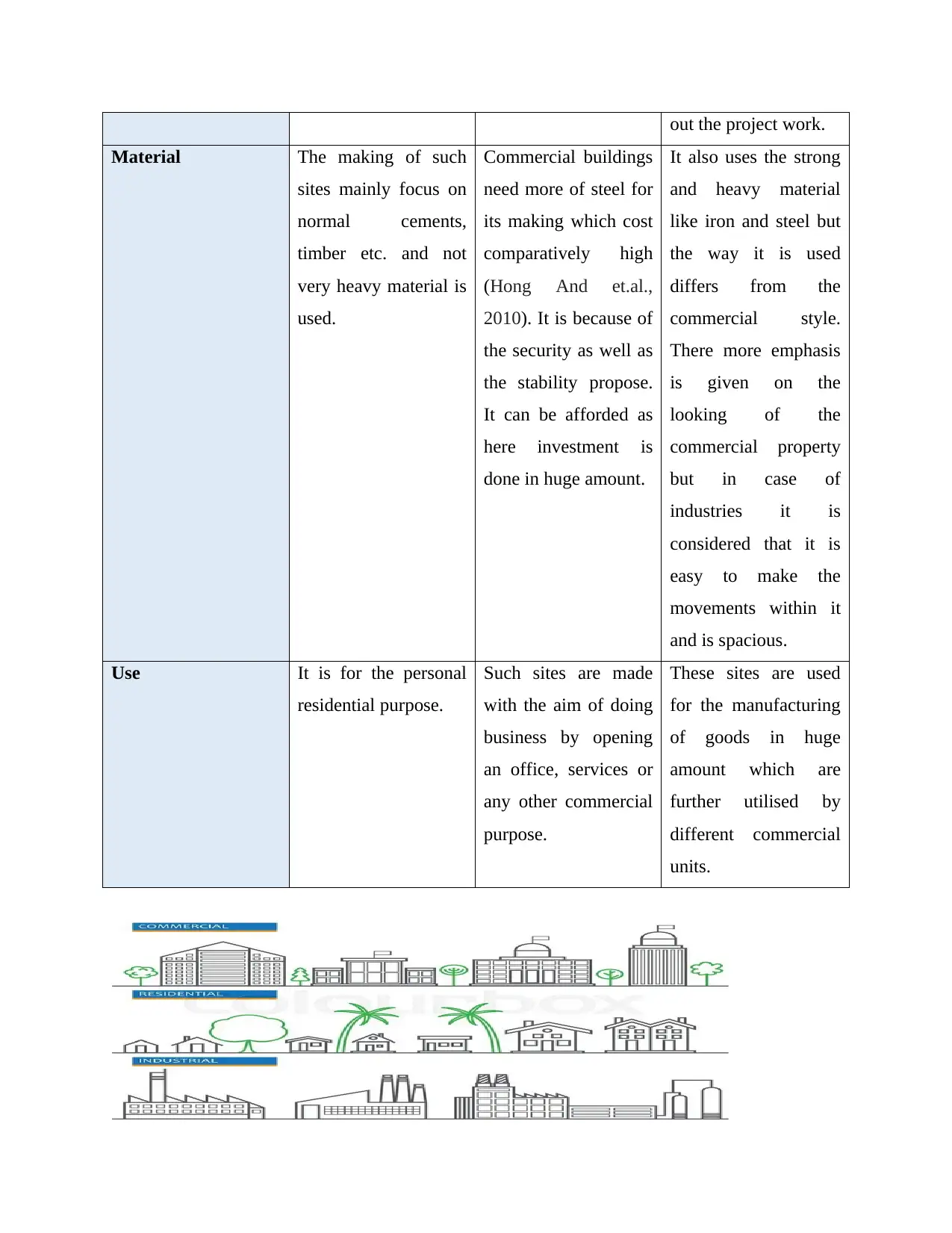
out the project work.
Material The making of such
sites mainly focus on
normal cements,
timber etc. and not
very heavy material is
used.
Commercial buildings
need more of steel for
its making which cost
comparatively high
(Hong And et.al.,
2010). It is because of
the security as well as
the stability propose.
It can be afforded as
here investment is
done in huge amount.
It also uses the strong
and heavy material
like iron and steel but
the way it is used
differs from the
commercial style.
There more emphasis
is given on the
looking of the
commercial property
but in case of
industries it is
considered that it is
easy to make the
movements within it
and is spacious.
Use It is for the personal
residential purpose.
Such sites are made
with the aim of doing
business by opening
an office, services or
any other commercial
purpose.
These sites are used
for the manufacturing
of goods in huge
amount which are
further utilised by
different commercial
units.
Material The making of such
sites mainly focus on
normal cements,
timber etc. and not
very heavy material is
used.
Commercial buildings
need more of steel for
its making which cost
comparatively high
(Hong And et.al.,
2010). It is because of
the security as well as
the stability propose.
It can be afforded as
here investment is
done in huge amount.
It also uses the strong
and heavy material
like iron and steel but
the way it is used
differs from the
commercial style.
There more emphasis
is given on the
looking of the
commercial property
but in case of
industries it is
considered that it is
easy to make the
movements within it
and is spacious.
Use It is for the personal
residential purpose.
Such sites are made
with the aim of doing
business by opening
an office, services or
any other commercial
purpose.
These sites are used
for the manufacturing
of goods in huge
amount which are
further utilised by
different commercial
units.
Paraphrase This Document
Need a fresh take? Get an instant paraphrase of this document with our AI Paraphraser
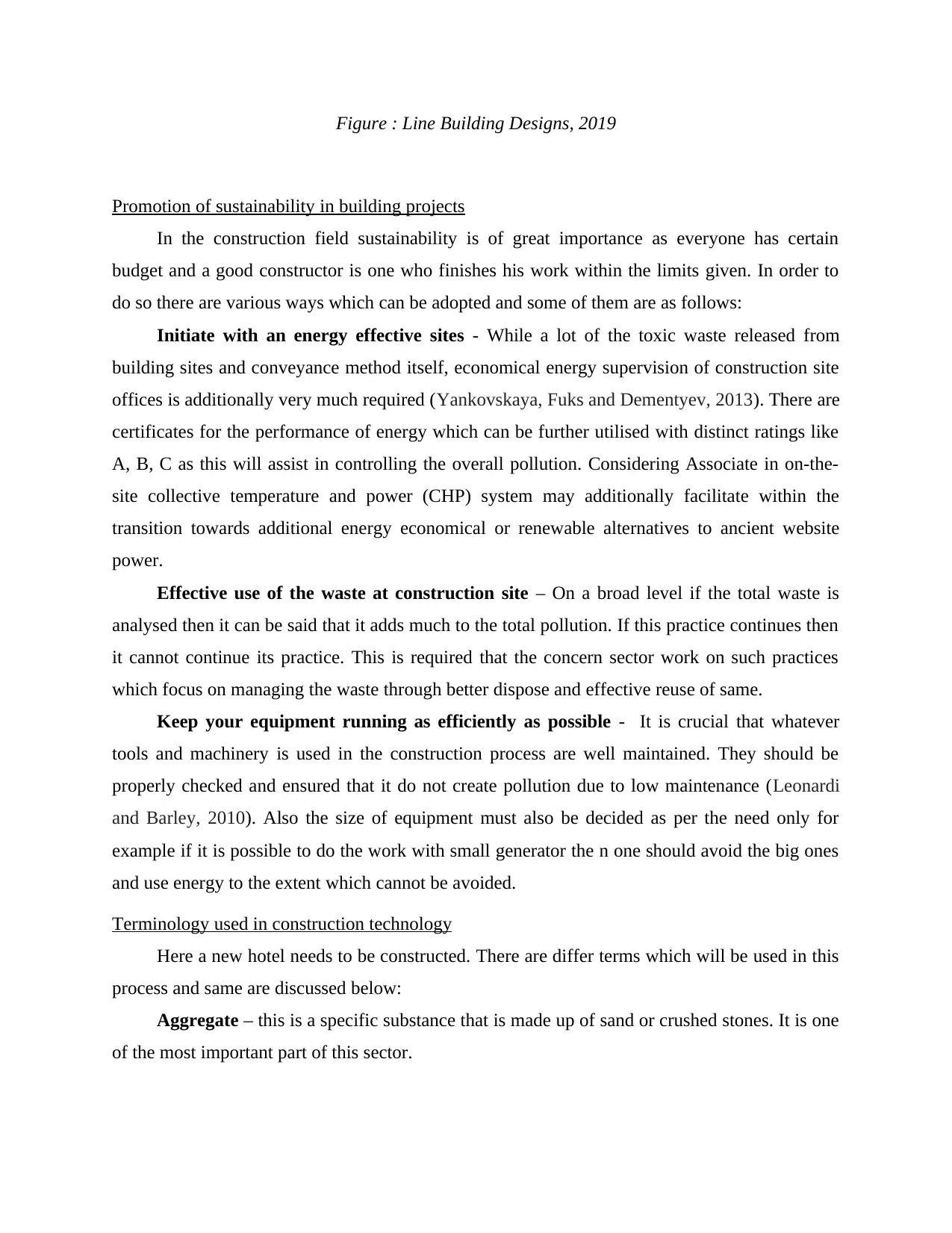
Figure : Line Building Designs, 2019
Promotion of sustainability in building projects
In the construction field sustainability is of great importance as everyone has certain
budget and a good constructor is one who finishes his work within the limits given. In order to
do so there are various ways which can be adopted and some of them are as follows:
Initiate with an energy effective sites - While a lot of the toxic waste released from
building sites and conveyance method itself, economical energy supervision of construction site
offices is additionally very much required (Yankovskaya, Fuks and Dementyev, 2013). There are
certificates for the performance of energy which can be further utilised with distinct ratings like
A, B, C as this will assist in controlling the overall pollution. Considering Associate in on-the-
site collective temperature and power (CHP) system may additionally facilitate within the
transition towards additional energy economical or renewable alternatives to ancient website
power.
Effective use of the waste at construction site – On a broad level if the total waste is
analysed then it can be said that it adds much to the total pollution. If this practice continues then
it cannot continue its practice. This is required that the concern sector work on such practices
which focus on managing the waste through better dispose and effective reuse of same.
Keep your equipment running as efficiently as possible - It is crucial that whatever
tools and machinery is used in the construction process are well maintained. They should be
properly checked and ensured that it do not create pollution due to low maintenance (Leonardi
and Barley, 2010). Also the size of equipment must also be decided as per the need only for
example if it is possible to do the work with small generator the n one should avoid the big ones
and use energy to the extent which cannot be avoided.
Terminology used in construction technology
Here a new hotel needs to be constructed. There are differ terms which will be used in this
process and same are discussed below:
Aggregate – this is a specific substance that is made up of sand or crushed stones. It is one
of the most important part of this sector.
Promotion of sustainability in building projects
In the construction field sustainability is of great importance as everyone has certain
budget and a good constructor is one who finishes his work within the limits given. In order to
do so there are various ways which can be adopted and some of them are as follows:
Initiate with an energy effective sites - While a lot of the toxic waste released from
building sites and conveyance method itself, economical energy supervision of construction site
offices is additionally very much required (Yankovskaya, Fuks and Dementyev, 2013). There are
certificates for the performance of energy which can be further utilised with distinct ratings like
A, B, C as this will assist in controlling the overall pollution. Considering Associate in on-the-
site collective temperature and power (CHP) system may additionally facilitate within the
transition towards additional energy economical or renewable alternatives to ancient website
power.
Effective use of the waste at construction site – On a broad level if the total waste is
analysed then it can be said that it adds much to the total pollution. If this practice continues then
it cannot continue its practice. This is required that the concern sector work on such practices
which focus on managing the waste through better dispose and effective reuse of same.
Keep your equipment running as efficiently as possible - It is crucial that whatever
tools and machinery is used in the construction process are well maintained. They should be
properly checked and ensured that it do not create pollution due to low maintenance (Leonardi
and Barley, 2010). Also the size of equipment must also be decided as per the need only for
example if it is possible to do the work with small generator the n one should avoid the big ones
and use energy to the extent which cannot be avoided.
Terminology used in construction technology
Here a new hotel needs to be constructed. There are differ terms which will be used in this
process and same are discussed below:
Aggregate – this is a specific substance that is made up of sand or crushed stones. It is one
of the most important part of this sector.
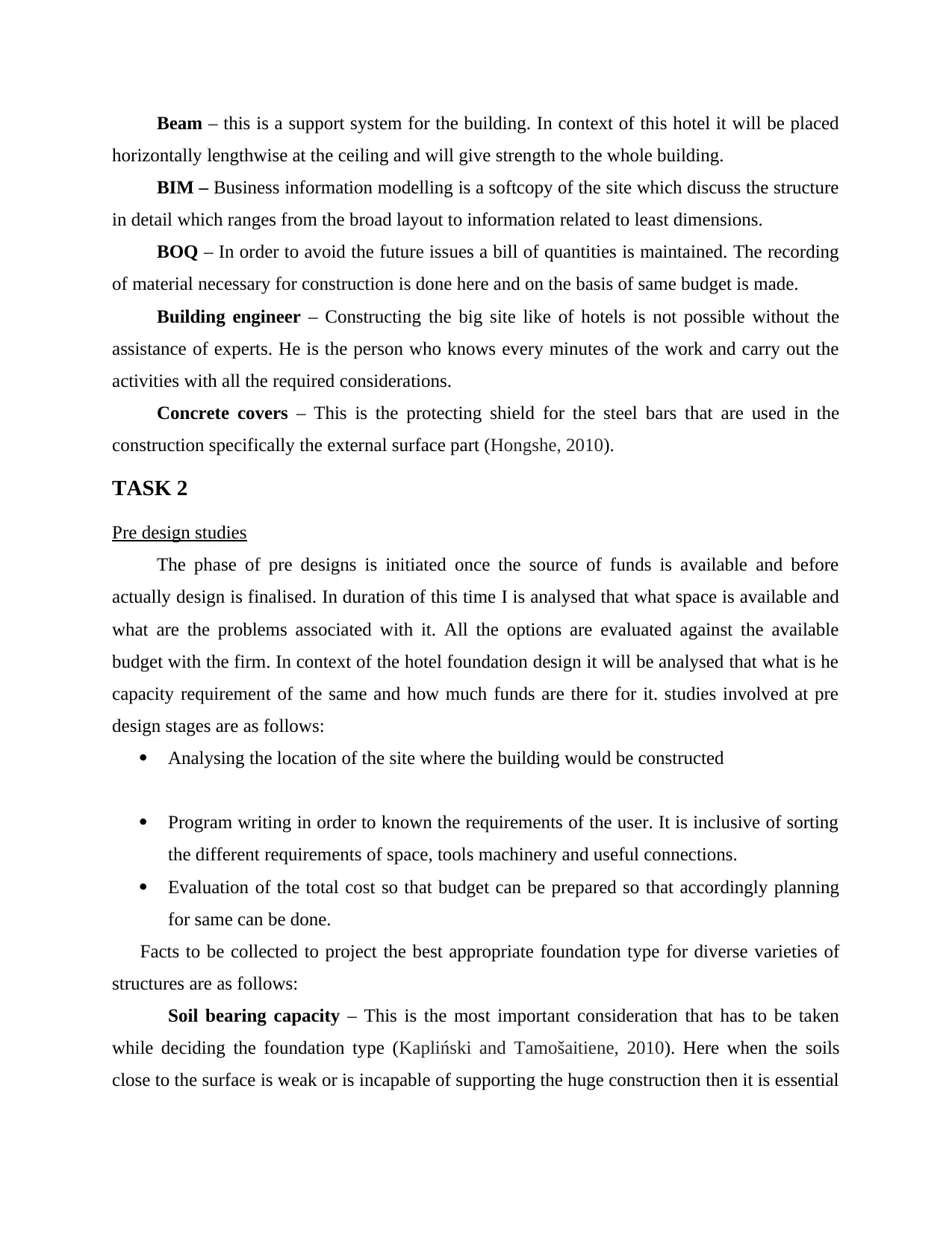
Beam – this is a support system for the building. In context of this hotel it will be placed
horizontally lengthwise at the ceiling and will give strength to the whole building.
BIM – Business information modelling is a softcopy of the site which discuss the structure
in detail which ranges from the broad layout to information related to least dimensions.
BOQ – In order to avoid the future issues a bill of quantities is maintained. The recording
of material necessary for construction is done here and on the basis of same budget is made.
Building engineer – Constructing the big site like of hotels is not possible without the
assistance of experts. He is the person who knows every minutes of the work and carry out the
activities with all the required considerations.
Concrete covers – This is the protecting shield for the steel bars that are used in the
construction specifically the external surface part (Hongshe, 2010).
TASK 2
Pre design studies
The phase of pre designs is initiated once the source of funds is available and before
actually design is finalised. In duration of this time I is analysed that what space is available and
what are the problems associated with it. All the options are evaluated against the available
budget with the firm. In context of the hotel foundation design it will be analysed that what is he
capacity requirement of the same and how much funds are there for it. studies involved at pre
design stages are as follows:
Analysing the location of the site where the building would be constructed
Program writing in order to known the requirements of the user. It is inclusive of sorting
the different requirements of space, tools machinery and useful connections.
Evaluation of the total cost so that budget can be prepared so that accordingly planning
for same can be done.
Facts to be collected to project the best appropriate foundation type for diverse varieties of
structures are as follows:
Soil bearing capacity – This is the most important consideration that has to be taken
while deciding the foundation type (Kapliński and Tamošaitiene, 2010). Here when the soils
close to the surface is weak or is incapable of supporting the huge construction then it is essential
horizontally lengthwise at the ceiling and will give strength to the whole building.
BIM – Business information modelling is a softcopy of the site which discuss the structure
in detail which ranges from the broad layout to information related to least dimensions.
BOQ – In order to avoid the future issues a bill of quantities is maintained. The recording
of material necessary for construction is done here and on the basis of same budget is made.
Building engineer – Constructing the big site like of hotels is not possible without the
assistance of experts. He is the person who knows every minutes of the work and carry out the
activities with all the required considerations.
Concrete covers – This is the protecting shield for the steel bars that are used in the
construction specifically the external surface part (Hongshe, 2010).
TASK 2
Pre design studies
The phase of pre designs is initiated once the source of funds is available and before
actually design is finalised. In duration of this time I is analysed that what space is available and
what are the problems associated with it. All the options are evaluated against the available
budget with the firm. In context of the hotel foundation design it will be analysed that what is he
capacity requirement of the same and how much funds are there for it. studies involved at pre
design stages are as follows:
Analysing the location of the site where the building would be constructed
Program writing in order to known the requirements of the user. It is inclusive of sorting
the different requirements of space, tools machinery and useful connections.
Evaluation of the total cost so that budget can be prepared so that accordingly planning
for same can be done.
Facts to be collected to project the best appropriate foundation type for diverse varieties of
structures are as follows:
Soil bearing capacity – This is the most important consideration that has to be taken
while deciding the foundation type (Kapliński and Tamošaitiene, 2010). Here when the soils
close to the surface is weak or is incapable of supporting the huge construction then it is essential
⊘ This is a preview!⊘
Do you want full access?
Subscribe today to unlock all pages.

Trusted by 1+ million students worldwide
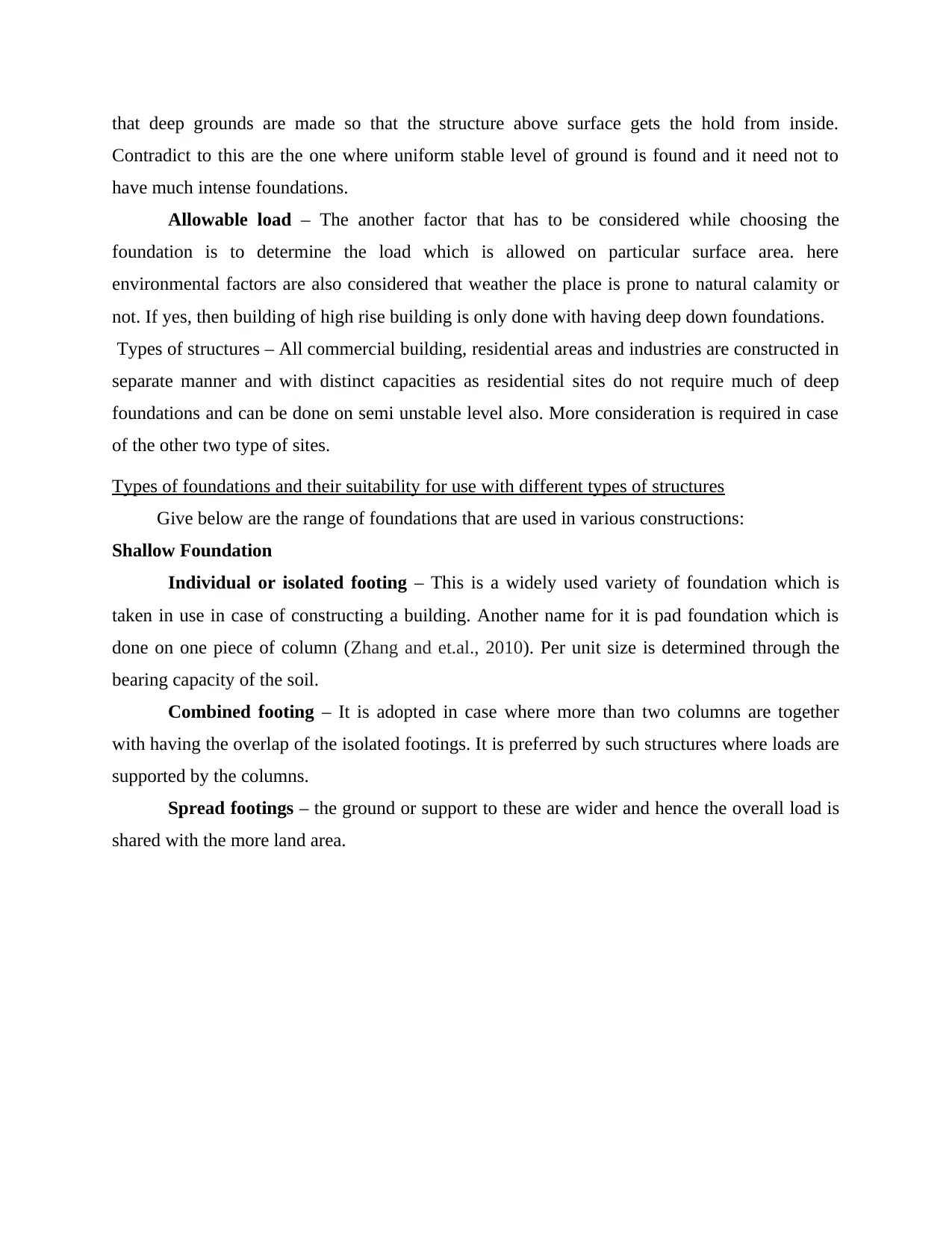
that deep grounds are made so that the structure above surface gets the hold from inside.
Contradict to this are the one where uniform stable level of ground is found and it need not to
have much intense foundations.
Allowable load – The another factor that has to be considered while choosing the
foundation is to determine the load which is allowed on particular surface area. here
environmental factors are also considered that weather the place is prone to natural calamity or
not. If yes, then building of high rise building is only done with having deep down foundations.
Types of structures – All commercial building, residential areas and industries are constructed in
separate manner and with distinct capacities as residential sites do not require much of deep
foundations and can be done on semi unstable level also. More consideration is required in case
of the other two type of sites.
Types of foundations and their suitability for use with different types of structures
Give below are the range of foundations that are used in various constructions:
Shallow Foundation
Individual or isolated footing – This is a widely used variety of foundation which is
taken in use in case of constructing a building. Another name for it is pad foundation which is
done on one piece of column (Zhang and et.al., 2010). Per unit size is determined through the
bearing capacity of the soil.
Combined footing – It is adopted in case where more than two columns are together
with having the overlap of the isolated footings. It is preferred by such structures where loads are
supported by the columns.
Spread footings – the ground or support to these are wider and hence the overall load is
shared with the more land area.
Contradict to this are the one where uniform stable level of ground is found and it need not to
have much intense foundations.
Allowable load – The another factor that has to be considered while choosing the
foundation is to determine the load which is allowed on particular surface area. here
environmental factors are also considered that weather the place is prone to natural calamity or
not. If yes, then building of high rise building is only done with having deep down foundations.
Types of structures – All commercial building, residential areas and industries are constructed in
separate manner and with distinct capacities as residential sites do not require much of deep
foundations and can be done on semi unstable level also. More consideration is required in case
of the other two type of sites.
Types of foundations and their suitability for use with different types of structures
Give below are the range of foundations that are used in various constructions:
Shallow Foundation
Individual or isolated footing – This is a widely used variety of foundation which is
taken in use in case of constructing a building. Another name for it is pad foundation which is
done on one piece of column (Zhang and et.al., 2010). Per unit size is determined through the
bearing capacity of the soil.
Combined footing – It is adopted in case where more than two columns are together
with having the overlap of the isolated footings. It is preferred by such structures where loads are
supported by the columns.
Spread footings – the ground or support to these are wider and hence the overall load is
shared with the more land area.
Paraphrase This Document
Need a fresh take? Get an instant paraphrase of this document with our AI Paraphraser
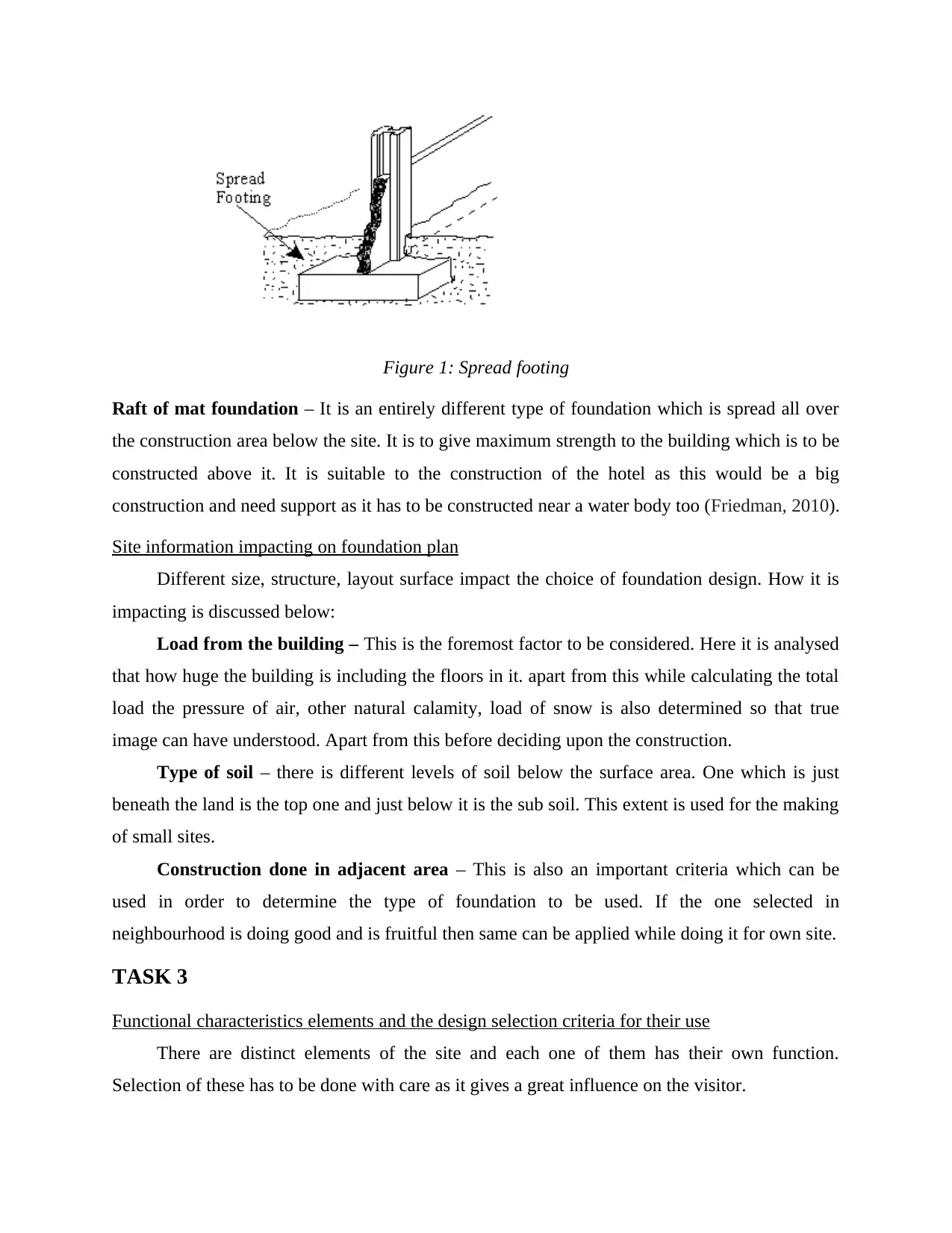
Figure 1: Spread footing
Raft of mat foundation – It is an entirely different type of foundation which is spread all over
the construction area below the site. It is to give maximum strength to the building which is to be
constructed above it. It is suitable to the construction of the hotel as this would be a big
construction and need support as it has to be constructed near a water body too (Friedman, 2010).
Site information impacting on foundation plan
Different size, structure, layout surface impact the choice of foundation design. How it is
impacting is discussed below:
Load from the building – This is the foremost factor to be considered. Here it is analysed
that how huge the building is including the floors in it. apart from this while calculating the total
load the pressure of air, other natural calamity, load of snow is also determined so that true
image can have understood. Apart from this before deciding upon the construction.
Type of soil – there is different levels of soil below the surface area. One which is just
beneath the land is the top one and just below it is the sub soil. This extent is used for the making
of small sites.
Construction done in adjacent area – This is also an important criteria which can be
used in order to determine the type of foundation to be used. If the one selected in
neighbourhood is doing good and is fruitful then same can be applied while doing it for own site.
TASK 3
Functional characteristics elements and the design selection criteria for their use
There are distinct elements of the site and each one of them has their own function.
Selection of these has to be done with care as it gives a great influence on the visitor.
Raft of mat foundation – It is an entirely different type of foundation which is spread all over
the construction area below the site. It is to give maximum strength to the building which is to be
constructed above it. It is suitable to the construction of the hotel as this would be a big
construction and need support as it has to be constructed near a water body too (Friedman, 2010).
Site information impacting on foundation plan
Different size, structure, layout surface impact the choice of foundation design. How it is
impacting is discussed below:
Load from the building – This is the foremost factor to be considered. Here it is analysed
that how huge the building is including the floors in it. apart from this while calculating the total
load the pressure of air, other natural calamity, load of snow is also determined so that true
image can have understood. Apart from this before deciding upon the construction.
Type of soil – there is different levels of soil below the surface area. One which is just
beneath the land is the top one and just below it is the sub soil. This extent is used for the making
of small sites.
Construction done in adjacent area – This is also an important criteria which can be
used in order to determine the type of foundation to be used. If the one selected in
neighbourhood is doing good and is fruitful then same can be applied while doing it for own site.
TASK 3
Functional characteristics elements and the design selection criteria for their use
There are distinct elements of the site and each one of them has their own function.
Selection of these has to be done with care as it gives a great influence on the visitor.
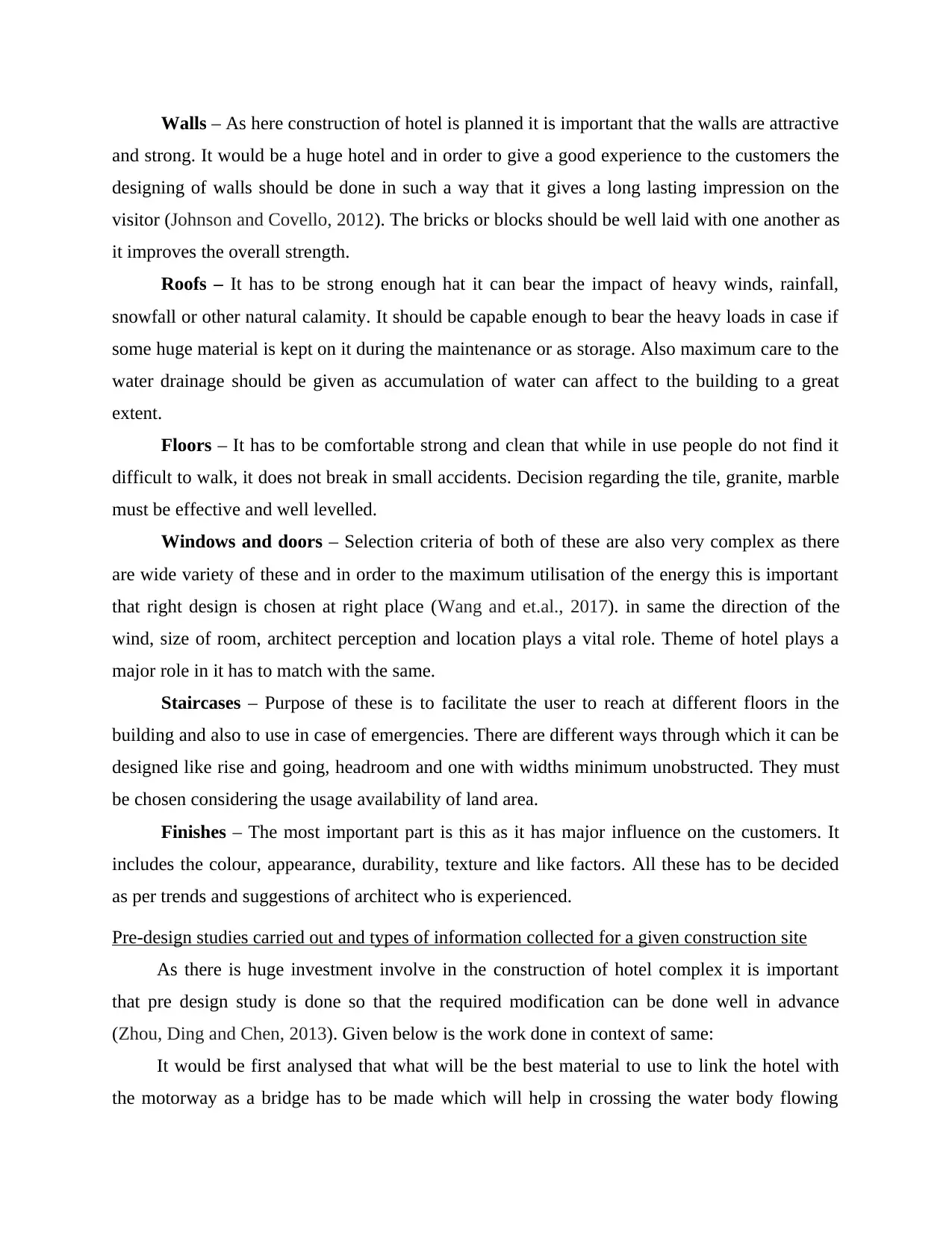
Walls – As here construction of hotel is planned it is important that the walls are attractive
and strong. It would be a huge hotel and in order to give a good experience to the customers the
designing of walls should be done in such a way that it gives a long lasting impression on the
visitor (Johnson and Covello, 2012). The bricks or blocks should be well laid with one another as
it improves the overall strength.
Roofs – It has to be strong enough hat it can bear the impact of heavy winds, rainfall,
snowfall or other natural calamity. It should be capable enough to bear the heavy loads in case if
some huge material is kept on it during the maintenance or as storage. Also maximum care to the
water drainage should be given as accumulation of water can affect to the building to a great
extent.
Floors – It has to be comfortable strong and clean that while in use people do not find it
difficult to walk, it does not break in small accidents. Decision regarding the tile, granite, marble
must be effective and well levelled.
Windows and doors – Selection criteria of both of these are also very complex as there
are wide variety of these and in order to the maximum utilisation of the energy this is important
that right design is chosen at right place (Wang and et.al., 2017). in same the direction of the
wind, size of room, architect perception and location plays a vital role. Theme of hotel plays a
major role in it has to match with the same.
Staircases – Purpose of these is to facilitate the user to reach at different floors in the
building and also to use in case of emergencies. There are different ways through which it can be
designed like rise and going, headroom and one with widths minimum unobstructed. They must
be chosen considering the usage availability of land area.
Finishes – The most important part is this as it has major influence on the customers. It
includes the colour, appearance, durability, texture and like factors. All these has to be decided
as per trends and suggestions of architect who is experienced.
Pre-design studies carried out and types of information collected for a given construction site
As there is huge investment involve in the construction of hotel complex it is important
that pre design study is done so that the required modification can be done well in advance
(Zhou, Ding and Chen, 2013). Given below is the work done in context of same:
It would be first analysed that what will be the best material to use to link the hotel with
the motorway as a bridge has to be made which will help in crossing the water body flowing
and strong. It would be a huge hotel and in order to give a good experience to the customers the
designing of walls should be done in such a way that it gives a long lasting impression on the
visitor (Johnson and Covello, 2012). The bricks or blocks should be well laid with one another as
it improves the overall strength.
Roofs – It has to be strong enough hat it can bear the impact of heavy winds, rainfall,
snowfall or other natural calamity. It should be capable enough to bear the heavy loads in case if
some huge material is kept on it during the maintenance or as storage. Also maximum care to the
water drainage should be given as accumulation of water can affect to the building to a great
extent.
Floors – It has to be comfortable strong and clean that while in use people do not find it
difficult to walk, it does not break in small accidents. Decision regarding the tile, granite, marble
must be effective and well levelled.
Windows and doors – Selection criteria of both of these are also very complex as there
are wide variety of these and in order to the maximum utilisation of the energy this is important
that right design is chosen at right place (Wang and et.al., 2017). in same the direction of the
wind, size of room, architect perception and location plays a vital role. Theme of hotel plays a
major role in it has to match with the same.
Staircases – Purpose of these is to facilitate the user to reach at different floors in the
building and also to use in case of emergencies. There are different ways through which it can be
designed like rise and going, headroom and one with widths minimum unobstructed. They must
be chosen considering the usage availability of land area.
Finishes – The most important part is this as it has major influence on the customers. It
includes the colour, appearance, durability, texture and like factors. All these has to be decided
as per trends and suggestions of architect who is experienced.
Pre-design studies carried out and types of information collected for a given construction site
As there is huge investment involve in the construction of hotel complex it is important
that pre design study is done so that the required modification can be done well in advance
(Zhou, Ding and Chen, 2013). Given below is the work done in context of same:
It would be first analysed that what will be the best material to use to link the hotel with
the motorway as a bridge has to be made which will help in crossing the water body flowing
⊘ This is a preview!⊘
Do you want full access?
Subscribe today to unlock all pages.

Trusted by 1+ million students worldwide
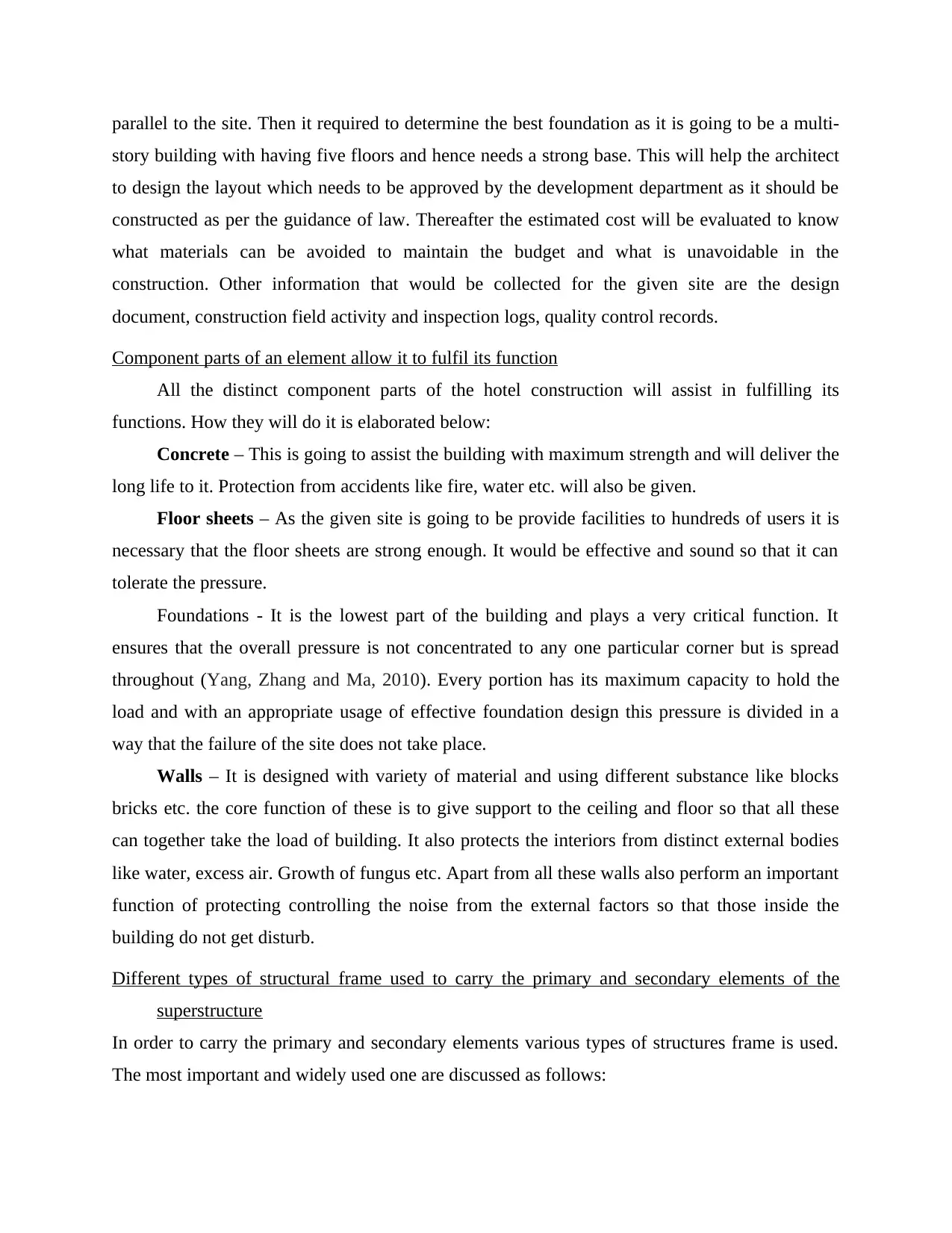
parallel to the site. Then it required to determine the best foundation as it is going to be a multi-
story building with having five floors and hence needs a strong base. This will help the architect
to design the layout which needs to be approved by the development department as it should be
constructed as per the guidance of law. Thereafter the estimated cost will be evaluated to know
what materials can be avoided to maintain the budget and what is unavoidable in the
construction. Other information that would be collected for the given site are the design
document, construction field activity and inspection logs, quality control records.
Component parts of an element allow it to fulfil its function
All the distinct component parts of the hotel construction will assist in fulfilling its
functions. How they will do it is elaborated below:
Concrete – This is going to assist the building with maximum strength and will deliver the
long life to it. Protection from accidents like fire, water etc. will also be given.
Floor sheets – As the given site is going to be provide facilities to hundreds of users it is
necessary that the floor sheets are strong enough. It would be effective and sound so that it can
tolerate the pressure.
Foundations - It is the lowest part of the building and plays a very critical function. It
ensures that the overall pressure is not concentrated to any one particular corner but is spread
throughout (Yang, Zhang and Ma, 2010). Every portion has its maximum capacity to hold the
load and with an appropriate usage of effective foundation design this pressure is divided in a
way that the failure of the site does not take place.
Walls – It is designed with variety of material and using different substance like blocks
bricks etc. the core function of these is to give support to the ceiling and floor so that all these
can together take the load of building. It also protects the interiors from distinct external bodies
like water, excess air. Growth of fungus etc. Apart from all these walls also perform an important
function of protecting controlling the noise from the external factors so that those inside the
building do not get disturb.
Different types of structural frame used to carry the primary and secondary elements of the
superstructure
In order to carry the primary and secondary elements various types of structures frame is used.
The most important and widely used one are discussed as follows:
story building with having five floors and hence needs a strong base. This will help the architect
to design the layout which needs to be approved by the development department as it should be
constructed as per the guidance of law. Thereafter the estimated cost will be evaluated to know
what materials can be avoided to maintain the budget and what is unavoidable in the
construction. Other information that would be collected for the given site are the design
document, construction field activity and inspection logs, quality control records.
Component parts of an element allow it to fulfil its function
All the distinct component parts of the hotel construction will assist in fulfilling its
functions. How they will do it is elaborated below:
Concrete – This is going to assist the building with maximum strength and will deliver the
long life to it. Protection from accidents like fire, water etc. will also be given.
Floor sheets – As the given site is going to be provide facilities to hundreds of users it is
necessary that the floor sheets are strong enough. It would be effective and sound so that it can
tolerate the pressure.
Foundations - It is the lowest part of the building and plays a very critical function. It
ensures that the overall pressure is not concentrated to any one particular corner but is spread
throughout (Yang, Zhang and Ma, 2010). Every portion has its maximum capacity to hold the
load and with an appropriate usage of effective foundation design this pressure is divided in a
way that the failure of the site does not take place.
Walls – It is designed with variety of material and using different substance like blocks
bricks etc. the core function of these is to give support to the ceiling and floor so that all these
can together take the load of building. It also protects the interiors from distinct external bodies
like water, excess air. Growth of fungus etc. Apart from all these walls also perform an important
function of protecting controlling the noise from the external factors so that those inside the
building do not get disturb.
Different types of structural frame used to carry the primary and secondary elements of the
superstructure
In order to carry the primary and secondary elements various types of structures frame is used.
The most important and widely used one are discussed as follows:
Paraphrase This Document
Need a fresh take? Get an instant paraphrase of this document with our AI Paraphraser
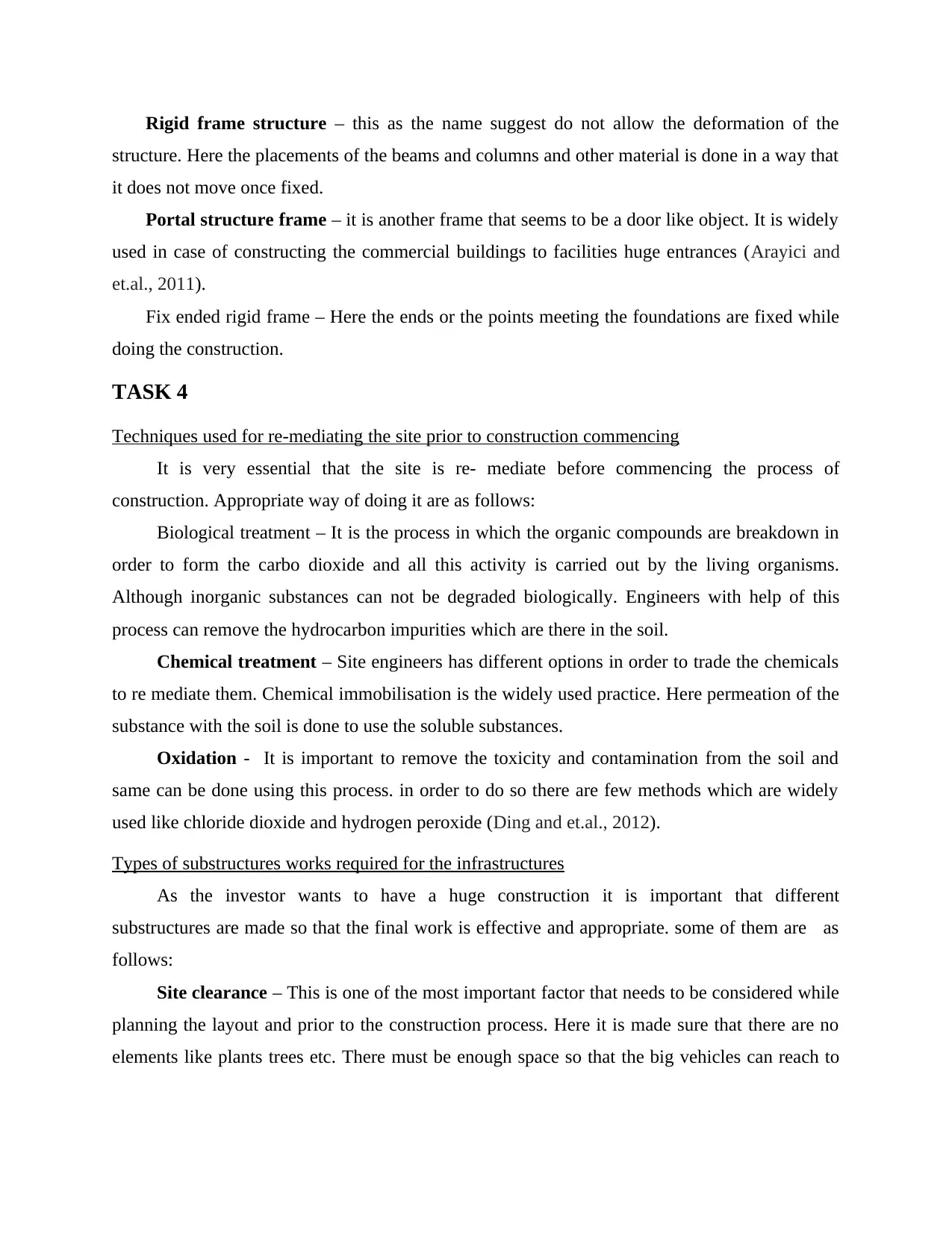
Rigid frame structure – this as the name suggest do not allow the deformation of the
structure. Here the placements of the beams and columns and other material is done in a way that
it does not move once fixed.
Portal structure frame – it is another frame that seems to be a door like object. It is widely
used in case of constructing the commercial buildings to facilities huge entrances (Arayici and
et.al., 2011).
Fix ended rigid frame – Here the ends or the points meeting the foundations are fixed while
doing the construction.
TASK 4
Techniques used for re-mediating the site prior to construction commencing
It is very essential that the site is re- mediate before commencing the process of
construction. Appropriate way of doing it are as follows:
Biological treatment – It is the process in which the organic compounds are breakdown in
order to form the carbo dioxide and all this activity is carried out by the living organisms.
Although inorganic substances can not be degraded biologically. Engineers with help of this
process can remove the hydrocarbon impurities which are there in the soil.
Chemical treatment – Site engineers has different options in order to trade the chemicals
to re mediate them. Chemical immobilisation is the widely used practice. Here permeation of the
substance with the soil is done to use the soluble substances.
Oxidation - It is important to remove the toxicity and contamination from the soil and
same can be done using this process. in order to do so there are few methods which are widely
used like chloride dioxide and hydrogen peroxide (Ding and et.al., 2012).
Types of substructures works required for the infrastructures
As the investor wants to have a huge construction it is important that different
substructures are made so that the final work is effective and appropriate. some of them are as
follows:
Site clearance – This is one of the most important factor that needs to be considered while
planning the layout and prior to the construction process. Here it is made sure that there are no
elements like plants trees etc. There must be enough space so that the big vehicles can reach to
structure. Here the placements of the beams and columns and other material is done in a way that
it does not move once fixed.
Portal structure frame – it is another frame that seems to be a door like object. It is widely
used in case of constructing the commercial buildings to facilities huge entrances (Arayici and
et.al., 2011).
Fix ended rigid frame – Here the ends or the points meeting the foundations are fixed while
doing the construction.
TASK 4
Techniques used for re-mediating the site prior to construction commencing
It is very essential that the site is re- mediate before commencing the process of
construction. Appropriate way of doing it are as follows:
Biological treatment – It is the process in which the organic compounds are breakdown in
order to form the carbo dioxide and all this activity is carried out by the living organisms.
Although inorganic substances can not be degraded biologically. Engineers with help of this
process can remove the hydrocarbon impurities which are there in the soil.
Chemical treatment – Site engineers has different options in order to trade the chemicals
to re mediate them. Chemical immobilisation is the widely used practice. Here permeation of the
substance with the soil is done to use the soluble substances.
Oxidation - It is important to remove the toxicity and contamination from the soil and
same can be done using this process. in order to do so there are few methods which are widely
used like chloride dioxide and hydrogen peroxide (Ding and et.al., 2012).
Types of substructures works required for the infrastructures
As the investor wants to have a huge construction it is important that different
substructures are made so that the final work is effective and appropriate. some of them are as
follows:
Site clearance – This is one of the most important factor that needs to be considered while
planning the layout and prior to the construction process. Here it is made sure that there are no
elements like plants trees etc. There must be enough space so that the big vehicles can reach to
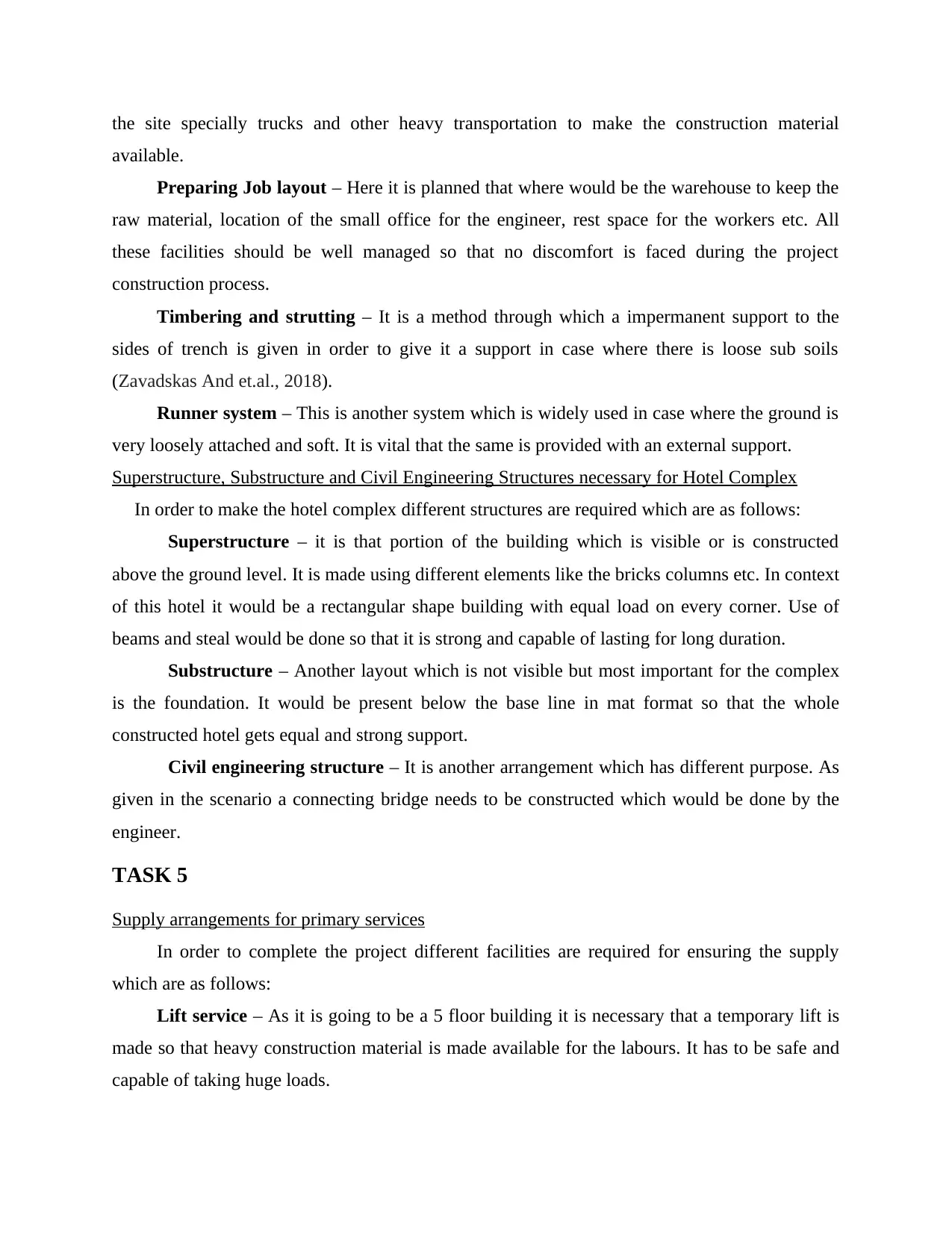
the site specially trucks and other heavy transportation to make the construction material
available.
Preparing Job layout – Here it is planned that where would be the warehouse to keep the
raw material, location of the small office for the engineer, rest space for the workers etc. All
these facilities should be well managed so that no discomfort is faced during the project
construction process.
Timbering and strutting – It is a method through which a impermanent support to the
sides of trench is given in order to give it a support in case where there is loose sub soils
(Zavadskas And et.al., 2018).
Runner system – This is another system which is widely used in case where the ground is
very loosely attached and soft. It is vital that the same is provided with an external support.
Superstructure, Substructure and Civil Engineering Structures necessary for Hotel Complex
In order to make the hotel complex different structures are required which are as follows:
Superstructure – it is that portion of the building which is visible or is constructed
above the ground level. It is made using different elements like the bricks columns etc. In context
of this hotel it would be a rectangular shape building with equal load on every corner. Use of
beams and steal would be done so that it is strong and capable of lasting for long duration.
Substructure – Another layout which is not visible but most important for the complex
is the foundation. It would be present below the base line in mat format so that the whole
constructed hotel gets equal and strong support.
Civil engineering structure – It is another arrangement which has different purpose. As
given in the scenario a connecting bridge needs to be constructed which would be done by the
engineer.
TASK 5
Supply arrangements for primary services
In order to complete the project different facilities are required for ensuring the supply
which are as follows:
Lift service – As it is going to be a 5 floor building it is necessary that a temporary lift is
made so that heavy construction material is made available for the labours. It has to be safe and
capable of taking huge loads.
available.
Preparing Job layout – Here it is planned that where would be the warehouse to keep the
raw material, location of the small office for the engineer, rest space for the workers etc. All
these facilities should be well managed so that no discomfort is faced during the project
construction process.
Timbering and strutting – It is a method through which a impermanent support to the
sides of trench is given in order to give it a support in case where there is loose sub soils
(Zavadskas And et.al., 2018).
Runner system – This is another system which is widely used in case where the ground is
very loosely attached and soft. It is vital that the same is provided with an external support.
Superstructure, Substructure and Civil Engineering Structures necessary for Hotel Complex
In order to make the hotel complex different structures are required which are as follows:
Superstructure – it is that portion of the building which is visible or is constructed
above the ground level. It is made using different elements like the bricks columns etc. In context
of this hotel it would be a rectangular shape building with equal load on every corner. Use of
beams and steal would be done so that it is strong and capable of lasting for long duration.
Substructure – Another layout which is not visible but most important for the complex
is the foundation. It would be present below the base line in mat format so that the whole
constructed hotel gets equal and strong support.
Civil engineering structure – It is another arrangement which has different purpose. As
given in the scenario a connecting bridge needs to be constructed which would be done by the
engineer.
TASK 5
Supply arrangements for primary services
In order to complete the project different facilities are required for ensuring the supply
which are as follows:
Lift service – As it is going to be a 5 floor building it is necessary that a temporary lift is
made so that heavy construction material is made available for the labours. It has to be safe and
capable of taking huge loads.
⊘ This is a preview!⊘
Do you want full access?
Subscribe today to unlock all pages.

Trusted by 1+ million students worldwide
1 out of 16
Related Documents
Your All-in-One AI-Powered Toolkit for Academic Success.
+13062052269
info@desklib.com
Available 24*7 on WhatsApp / Email
![[object Object]](/_next/static/media/star-bottom.7253800d.svg)
Unlock your academic potential
Copyright © 2020–2025 A2Z Services. All Rights Reserved. Developed and managed by ZUCOL.





